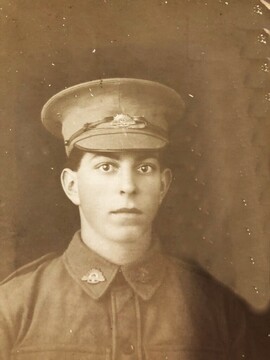DUN, Albert James
| Service Numbers: | 1710, N459566 |
|---|---|
| Enlisted: | 7 February 1916 |
| Last Rank: | Private |
| Last Unit: | 55th Infantry Battalion |
| Born: | Bulahdelah, New South Wales, Australia, 16 March 1896 |
| Home Town: | Bungwahl, Great Lakes, New South Wales |
| Schooling: | Bungwahl Public School, New South Wales, Australia |
| Occupation: | Wharf Hand |
| Died: | Natural Causes, Taree, New South Wales, Australia, 10 August 1973, aged 77 years |
| Cemetery: |
Rookwood Cemeteries & Crematorium, New South Wales The New South Wales Garden of Remembrance |
| Memorials: |
World War 1 Service
| 7 Feb 1916: | Enlisted AIF WW1, 1710 | |
|---|---|---|
| 1 May 1916: | Embarked AIF WW1, Private, 1710, 35th Infantry Battalion, --- :embarkation_roll: roll_number: '17' embarkation_place: Sydney embarkation_ship: HMAT Benalla embarkation_ship_number: A24 public_note: '' | |
| 16 Sep 1916: | Transferred AIF WW1, Private, 55th Infantry Battalion | |
| 12 Jul 1917: | Involvement 1710, Fromelles (Fleurbaix) | |
| 1 Jan 1918: | Involvement AIF WW1, Private, 1710, 55th Infantry Battalion, The Outpost Villages - German Withdrawal to Hindenburg Line | |
| 10 Mar 1918: | Wounded AIF WW1, Private, 1710, 55th Infantry Battalion, The Outpost Villages - German Withdrawal to Hindenburg Line | |
| 1 Jul 1919: | Discharged AIF WW1, Private, 1710, 55th Infantry Battalion |
World War 2 Service
| 6 May 1942: | Enlisted Australian Military Forces (WW2) , Private, N459566 |
|---|
Help us honour Albert James Dun's service by contributing information, stories, and images so that they can be preserved for future generations.
Add my storyBiography contributed by Peter Dun
Albert James Dun was born in Bulahdelah and worked the land with his father until WW1 was declared. At age twenty he went to Newcastle and was drafted to the 55th battalion 5th Division in Europe.
He survived 3 ½ years through France, Belgium and Germany.
He was wounded at Bullecourt with shell shrapnel, was hospitalised in London before returning to the front. He was mentioned in dispatches three times for bravery in rescuing fallen comrades in his position as stretcher bearer. He returned home from the war after further hospitalisation in England for mustard gas injuries.
Back home he went to work for Allen Taylor & Co at Bungwahl and at Mayers Flat, as a steam engine driver hauling timber from Wootton and that area to wharves at Mayers Flat from where it was taken by barges (punts) on the lake system to sawmills at Tea Gardens.
Albert married Philomena Payne in Bulahdelah on 22nd June 1929 and lived at Mayers Flat where three boys were born – John born in 1930, Brian in 1931 and Robert in 1933. They moved to Bulahdelah in approximately 1936 where he took a position as a logger for the Forestry Commission. Sometime later he moved to Elands on the Bulga Plateau in 1939 with the Forestry Commission, as the first Forest Ranger in that district to supervise logging of mill timber and poles plus control payment of timber milled at Wingham plus rail sleepers and mine props etc. During this period he specialised in coachwood selection and logging for peeling at the plywood mills for the manufacture of select plywood to use in the construction of the famous Beaufighter planes, a light bomber used by the RAAF in WW2 which was then in progress in the Middle East.
Philomena his dear wife died at Wingham hospital in 1941. Albert moved to Cundletown in 1944 when appointed Forester at the Taree Branch offices of the Forestry Commission. He married Arlien Clarice Thompson in 1944, and Bruce & Margaret were born during the time he lived at Cundletown.
Because of failing eye-sight, he moved to Manning State Forest at Coopernook in 1949 where he became well known for his bush fire fighting technique. He retired due to bad health in 1960 when he moved to Coopernook village until moving to Chatham in 1963 to be nearer to medical help until his death in 1973.
Albert always had a great interest in all sports, although not a gambler, horseracing from an early age was his delight.
A good rugby league player in his youth, he continued in following the sport when his sons played in the local area.










